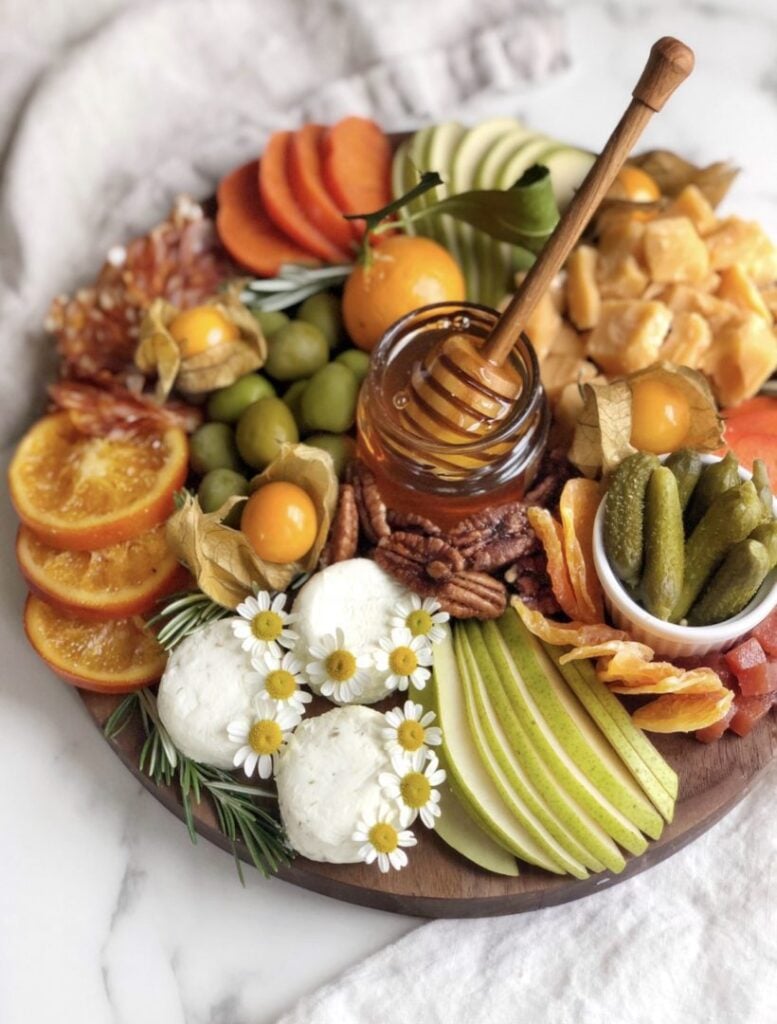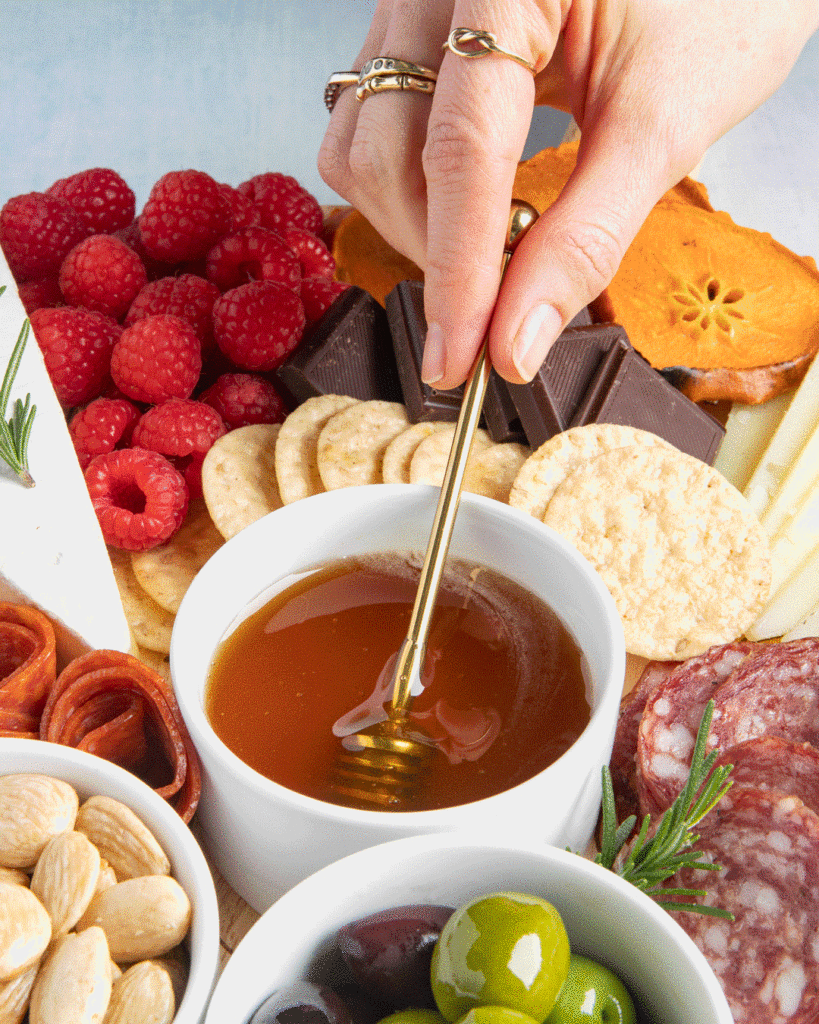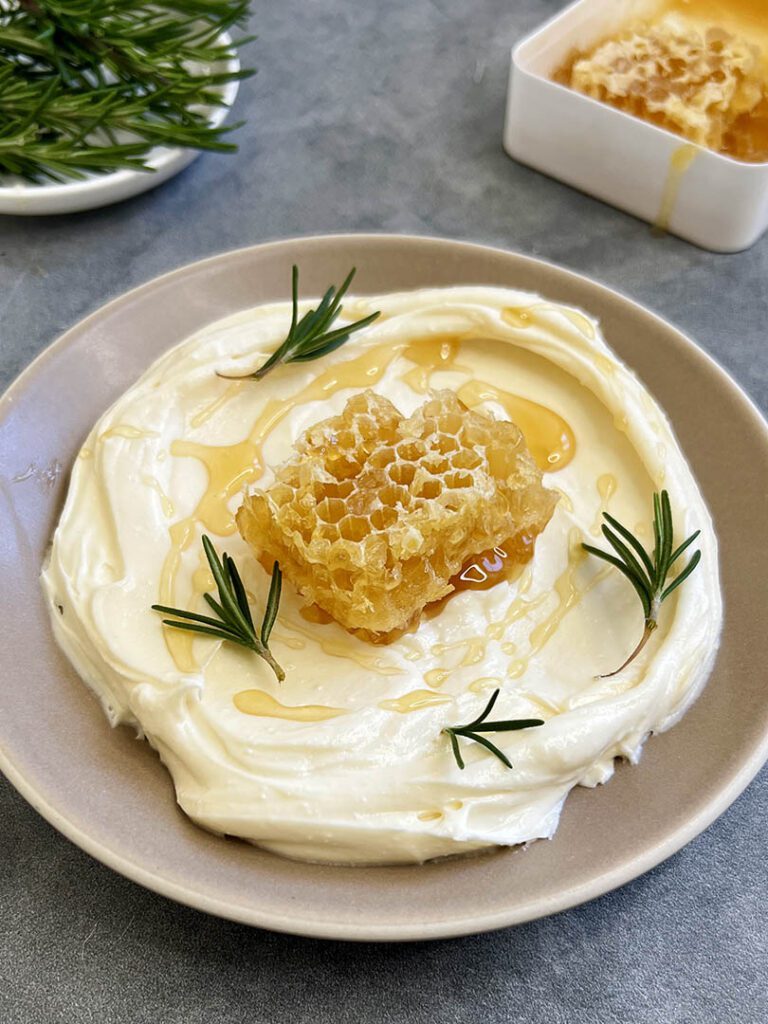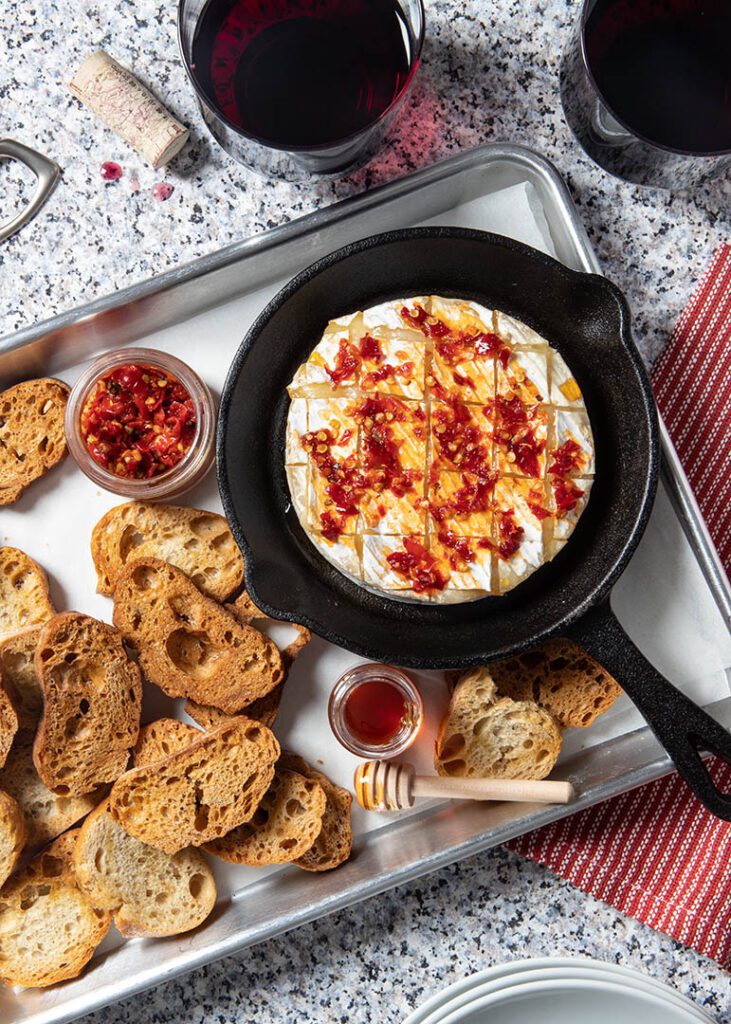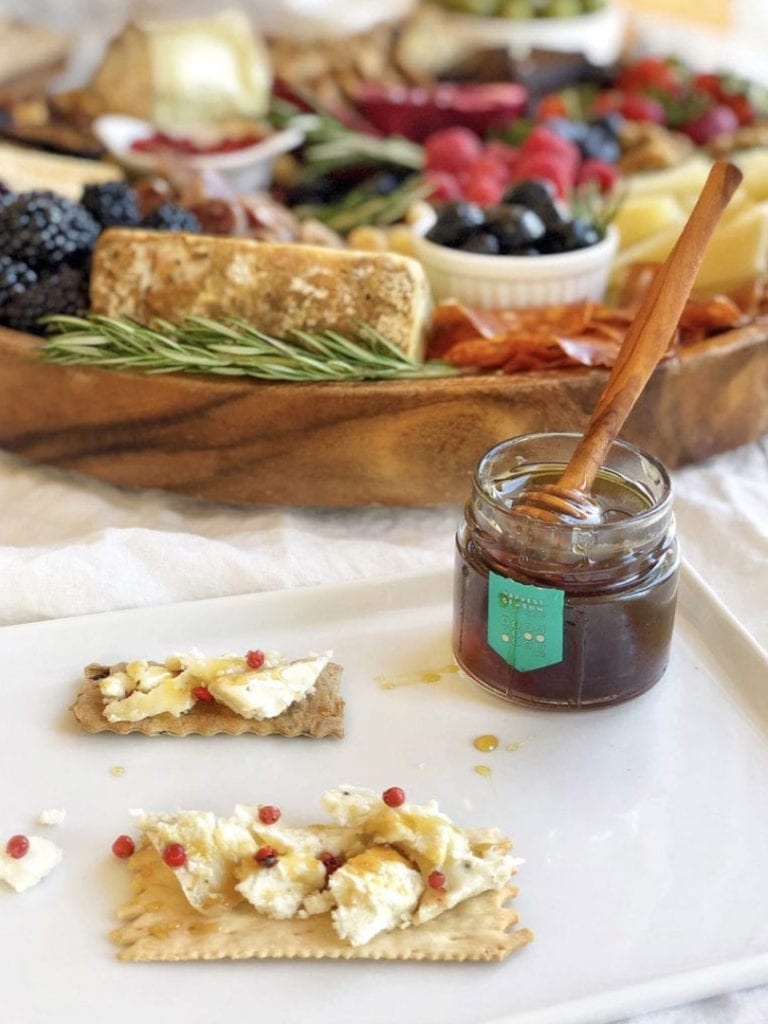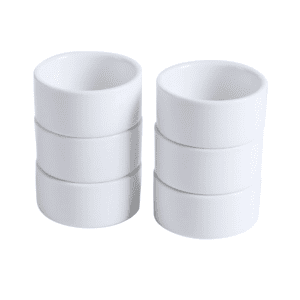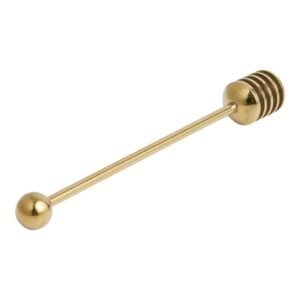This post contains collections of products that I personally recommend (it may contain affiliate links).
Cheese and honey are two of my most favorite things. I mean, cheese is obviously the top of my list, but if I could only pair one thing with cheese for the rest of my life, it would be honey! Really, nothing can top that classic combo of sweet and savory, but the best part about both cheese and honey is that there is so much variety.
If you’ve been following me for a while, you know that there is a huge range of cheeses, both in texture and flavor. What you may not know is that there is also a wide variety of honey flavors, mostly due to the various plant nectars that bees collect. (When I say I love honey, I mean it! I use it on so many of my boards that I created my very own honey dipper.)
I want you to love honey on cheese as much as I do, so I’m not only going to go over how to pair different cheeses with all the beautiful flavors of honey, but I’ll also share my go-to cheese and honey recipes!
To learn more about cheese pairings, check out my Wine & Cheese Pairings Guide, Chocolate and Cheese Pairing Board, Perfect Cheese Pairings, and Cheese Tasting Board.
Best Honey Varieties to Pair with Cheese
Honey primarily gets its flavor from the plant nectar that the bees harvest, and it ranges in color, flavor, and intensity. Here is a list of the most common honeys that you can easily find at the store:
- Acacia Honey: Harvested from black locust trees, this is one of the lightest and mildest honeys. It’s my go-to all-purpose honey!
- Clover Honey: Probably the most common honey, it’s made from clover flowers and is also light in color and mild in flavor, but it has sweeter, more floral notes. (I love Local Hive’s Clover honey–Local Hive is actually my favorite brand of honey!)
- Orange Blossom Honey: Made from the flowers on orange trees, this honey is on the lighter and milder side with some distinct floral and citrus notes. It’s superb in tea! (P.S. if you’re buying from a grocery store, be sure to check the label to make sure there are no added artificial flavors.)
- Wildflower Honey: On the bolder end of the spectrum, this honey is harvested from a variety of, you guessed it, wildflowers, so there is a range of fragrant floral notes to enjoy.
- Hot Honey: Made by infusing a mild honey, like clover, with chili peppers, this honey has a kick of heat, but a versatile flavor. (I love this hot honey.)
- Manuka Honey: This is a very special honey that is known for its anti-microbial and antioxidant properties. It comes from manuka trees, which only grow on the North Island of New Zealand, and has a thick texture and robust, earthy flavor. I like to drizzle it on toast!
- Buckwheat Honey: One of the darkest and boldest honeys, it leans somewhat nutty and bitter with a hint of molasses. It’s definitely not an everyday honey, but it definitely has its place on some cheese boards.
Pro tip: go to your local farmer’s market and nearby apiaries to try different kinds of honey! You may find something you like that you won’t find on grocery store shelves.
My Favorite Honey
It’s really important to me to buy locally and sustainably sourced honey when it’s available. Not only do I love enjoying honey with flavors harvested from my part of the country, but bees are in decline thanks to pesticides, habitat loss, and climate change! Bees pollinate 80% of the world’s flowering plants, which means they are incredibly important for agriculture.
This is why I love Local Hive Honey. They source raw and unfiltered honeys from more than 23 different beekeepers across the United States. Their honey blends not only taste good, but are also good for bees. You can shop for honey by region, so you can get a taste of home, or somewhere else entirely! No matter what, always look for “100% Pure Honey”. Grab their honey sampler to try a few.
What Cheeses to Pair with Honey
The first rule of honey and cheese pairing is that there really are no rules! It’s such an epic pairing that it’s pretty hard to go wrong. You can lean on complementary flavors (i.e. strong cheese and strong honey or mild cheese with mild honey) or go for contrast and pair a super bold cheese with a mild honey (and vice versa).
Here are some of my favorite cheeses to pair with honey:
- Chevre: This super soft, fresh goat cheese, usually served in a log, is creamy with a mild tang (in fact, there are some chevres that are pre-mixed with honey!). I like to pair this with a mild honey like clover or acacia so the delicate flavors of the cheese don’t get overpowered.
- Whipped goat cheese: This is made using chevre–I usually like to whip honey right into the cheese, like I do in my Honey Whipped Goat Cheese recipe. You could use a bolder honey, but my favorite is still clover or acacia so the chevre can shine.
- Brie: This soft cheese has a buttery texture and a pretty mild flavor. You can lean into the mild with clover or acacia honey, or you can pair brie with something bolder, like wildflower or hot honey, so the flavors of the honey really shine. (You could also whip the brie with honey to make a delicious Whipped Brie Dip)
- Ricotta: This is a fresh Italian cheese that’s super soft and creamy with a very mild flavor that leans a little sweet. I like to pair it with manuka or hot honey to balance that sweetness and add some complexity of flavor (try my Whipped Ricotta Dip with Hot Honey). If you want to lean more into the sweetness, try pairing it with orange blossom honey!
- Blue cheese: This is a broad term for a lot of cheeses that feature veins of mold cultures, which range in texture from creamy to crumbly–they all have a bold, tangy flavor. I like to pair this with an equally bold honey, like buckwheat, but you can easily go with mild acacia to let the sharpness of the cheese stand out.
- Boursin: A brand of Gournay cheese, Boursin is a super soft, herby cheese that’s quite savory. I like to pair it with a mild honey like acacia or clover to contrast the blast of flavor in the cheese. This is one cheese I definitely wouldn’t serve with a bold honey!
- Cottage cheese: I know, it’s not a traditional cheese board cheese, but it’s a great source of protein! I love to serve it whipped with honey and/or herbs for a slightly healthier take on a cheese dip. Because it’s so mild, if you serve it on its own, you could pair it with wild flower, manuka, or hot honey to let the honey flavors really shine. (I love to pair whipped cottage cheese & dates with honey!)
How To Serve Cheese & Honey
The easiest way to serve honey on a cheese board is in a ramekin with a honey dipper. That way, guests can decide how much honey they want, and it’s less messy to clean up. Pro tip: Spray the ramekin with cooking spray so it’s easier to clean.
I also love to use honeycomb as a garnish in my bowls of honey and directly on cheeses! Honeycomb is the hexagonal beeswax structure that the bees actually store the raw honey in, and it’s also safe to eat; mostly, I just think it’s beautiful. (See how I used it in my Whipped Brie Dip recipe.)
When I serve single-serve, handheld charcuterie, like Jar-Cuterie, Charcuterie Cups, or Charcuterie Cones, I love to use honey sticks! It’s a mess-free way to add honey to individual servings, and they’re fun to eat on their own!
Honey & Cheese: My Favorite Recipes & Bites
Here are some of my favorite ways to combine cheese and honey that go beyond serving a ramekin of honey on a cheese board.
Goat Cheese & Honey with Pistachios & Pomegranate
Roll a log of chevre in pistachios, pomegranate arils, and flaky salt, then drizzle it with a mild, floral honey like Local Hive’s Organic Hive Honey to complement the tangy chèvre and pomegranate.
Burrata & Honey-Topped Crostini with Arugula & Prosciutto
Top homemade crostini with burrata, lightly drizzle each with olive oil and sprinkle with salt, then top with arugula, prosciutto, and a citrusy honey, like Local Hive So Cal Honey, to cut the creaminess of the burrata.
Baked Brie & Honey with Garlic & Rosemary
Crosshatch a wheel of brie and top it with garlic, rosemary, and Local Hive Hot Honey for an herby, spicy kick. Bake it for 15 minutes at 350 degrees and enjoy with crostini or fresh-baked bread, like I do with my Baked Camembert with Hot Honey.
If you’re eyeing a cheese plate and are wondering about which combinations would go well together, here are some more tasty ideas:
- Cracker + goat cheese + slice of fresh persimmon + candied pecan + honey
- Rice cracker + salami + green apple + Gouda + honey
- Cracker + stilton + blackberry + honey
- Truffle goat cheese + pink peppercorns + honey
- Sourdough + Manchego + pistachios + honey
- Cracker + goat’s milk brie + pomegranate seeds + honey
- Cracker + apple + Havarti + honey
- Mild cracker + Camembert + pear + honey
FAQs: All About Honey
There are several factors that change based on the weather, but the biggest contributor is geography. Bees make honey by collecting nectar from nearby plants, and the plant nectar is what creates the flavor.
“Local honey” refers to honey harvested within a 50-mile radius of where you live.
It’s suggested that ingesting local pollen and nectar through honey can help reduce some allergy symptoms caused by those same local pollens.
This doesn’t mean that the honey is unclean; it just means that it has undergone minimal processing. It usually looks cloudier than processed honey because it retains pollen, which is where all the nutrients are!
Raw honey has not been pasteurized, which means it retains the honey’s naturally occurring enzymes, vitamins, and minerals, such as B vitamins, vitamins C and E, magnesium, and potassium.
Pure honey simply means that it is 100% honey with no added syrups or sweeteners. However, it has likely been filtered and pasteurized.
It’s slightly more expensive, but raw and unfiltered honey contains a number of health benefits, including improved immune function and digestion, reduced inflammation, wound healing, and microbial inhibition. According to the National Library of Medicine, bee propolis—a resin-like substance found in raw honey—has also been shown to possess anti-cancer properties.
I love the brand Beekeeper’s Naturals! They bottle the propolis for immune support; I swear by this Propolis Throat Spray. And when Rory gets older, I will definitely be giving her their kids’ products (throat soothing lollipops, throat spray, and cough syrup. They also have a Superfood Honey that you can eat for immune support and energy.
Simply put, it’s spicy honey. More specifically, it’s a mild honey, like clover honey, that has been infused with a chile or spice. I love Local Hive’s blends: jalepeño, Sriracha, and chipotle, but you can also make your own hot honey!
Show Me Your Cheese & Honey Pairings
I hope this post inspires you to serve honey on cheese. Nothing makes me happier than seeing the snacks and apps you create from my tips. If you make something inspired by this post, please tag me at @ainttooproudtomeg so I can see and share!
And, if you liked this guide, please rate and review.

